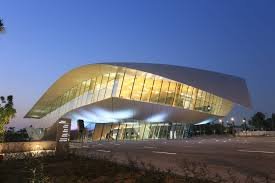Museums and cultural institutions in the UAE are undergoing a remarkable transformation. With technological advancements driving change, these spaces are no longer just traditional halls of artifacts. Instead, they are becoming immersive, interactive experiences that engage visitors in new and exciting ways. From virtual reality tours to AI-powered guides, digitization is opening up endless possibilities for both education and entertainment.
The Digital Shift in UAE Museums

In recent years, museums across the UAE have embraced digital tools to enhance their exhibits and appeal to a wider audience. Institutions such as the Louvre Abu Dhabi, Dubai Museum, and Sharjah Art Foundation have incorporated cutting-edge technologies to create engaging, memorable experiences for visitors.
Interactive touchscreens, augmented reality (AR), and virtual reality (VR) headsets are now commonly used to bring historical artifacts to life. Visitors can explore detailed 3D models of ancient sculptures, witness the restoration process of priceless artworks, or experience historical moments through immersive simulations.

Virtual Tours and Online Experiences
One significant benefit of digitization is accessibility. Many UAE museums now offer virtual tours that allow people from around the world to explore their collections without stepping foot inside the building. These online platforms provide high-resolution images, audio guides, and interactive maps that mimic the feeling of a physical visit.

For instance, the Louvre Abu Dhabi offers an exceptional virtual museum experience, where users can navigate through galleries using a digital interface. This has proved particularly beneficial during times when physical travel is restricted.
Artificial Intelligence and Personalized Guides
Artificial Intelligence (AI) is revolutionizing how visitors interact with museums. AI-powered chatbots and virtual guides provide real-time information, answer questions, and offer personalized recommendations based on user preferences. The Museum of the Future in Dubai employs AI to create a highly personalized visitor experience, making learning both interactive and tailored.
Through natural language processing, these virtual guides can converse with guests, narrate stories about artifacts, and offer insights that cater to different age groups and interests.
Augmented Reality: Blending the Past with the Present
Augmented Reality (AR) is bridging the gap between the past and present. By using smartphones or AR glasses, visitors can visualize how historical sites or ancient structures might have appeared centuries ago.
In Sharjah, the Sharjah Heritage Museum uses AR to showcase reconstructed models of traditional Emirati homes and markets. This technology creates an immersive experience, allowing visitors to step into history and witness the vibrant culture of the UAE’s past.
Digitization Preserving Cultural Heritage
Digitization also plays a crucial role in preserving cultural heritage. High-resolution 3D scanning and digital archiving techniques are being used to create detailed replicas of artifacts. These digital records serve as backups in case of damage or loss and can also be used for educational purposes.
The Department of Culture and Tourism – Abu Dhabi has undertaken several projects to digitize and preserve historic manuscripts and artwork. These digital archives ensure that future generations can access and appreciate the rich heritage of the UAE.
Engaging the Younger Generation
Museums are increasingly focusing on creating interactive and gamified experiences to attract younger audiences. Educational games, scavenger hunts using QR codes, and mobile apps with gamified challenges encourage children and teenagers to explore and learn.
For example, the Children’s Museum at Louvre Abu Dhabi offers interactive workshops and digital storytelling sessions designed to spark curiosity and creativity. Similarly, Dubai Future Foundation’s Innovation Hub allows children to explore AI, robotics, and virtual environments.
Sustainable Museums Through Technology
Digitization also contributes to sustainability. Virtual exhibits reduce the need for physical materials, while digital catalogs minimize paper use. Additionally, energy-efficient LED screens and motion-activated lighting systems are becoming standard in many institutions.
The UAE’s commitment to sustainability is evident in its museums’ efforts to balance technological innovation with environmental responsibility.
The Future Outlook
Looking ahead, the integration of blockchain technology for digital art authentication, holographic displays for historical reconstructions, and metaverse-based museums are expected to shape the future of cultural institutions in the UAE.
The Zayed National Museum, set to open in Abu Dhabi, is already planning to integrate immersive storytelling through AR and VR. Similarly, Expo City Dubai continues to push the boundaries of digital experiences, offering interactive exhibitions that celebrate human achievement.
Conclusion
The UAE is setting a global example in how museums can embrace digitization to offer enriching, inclusive, and sustainable experiences. Through virtual tours, AI-powered guides, and augmented reality, museums are no longer confined to physical spaces. They are evolving into dynamic cultural hubs that engage visitors of all ages.
For both locals and tourists, exploring these digital innovations offers a deeper understanding of the UAE’s rich history and vibrant future. Whether through a virtual visit or an in-person interactive experience, museums in the UAE are truly bringing the past to life through the power of technology.
Also read: How UAE’s Literacy Campaigns Are Inspiring a Nation of Readers!













